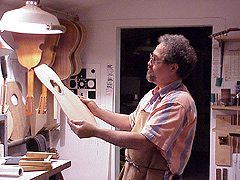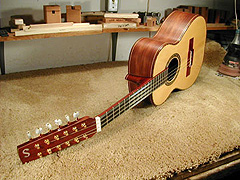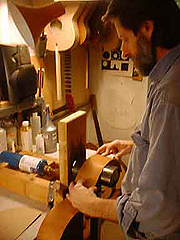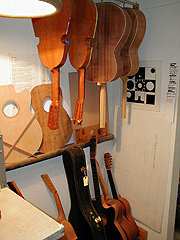
Ask a bunch of luthiers (musical instrument makers) to name the very best book on the subject of building guitars and, odds are, they will all answer “Guitarmaking: Tradition and Technology.” Since its publication in 1985, it has become regarded as the guitarmaker’s bible. The man primarily responsible for crafting this singular work, written with then-partner Jon Natelson, is William Cumpiano, but even this outstanding book pales in comparison to his talent as a luthier and teacher.
Since 1971, Bill Cumpiano has been building and repairing some of the finest handmade guitars and stringed instruments on the planet. Bill makes both American style instruments and those from the Latin American tradition, such as the requinto, the tres, the quatro, and the tiple. He has neither catalog nor models, because most instruments he builds are individually designed and crafted for the specific customer.
“One of the things that keeps me interested is the anticipation,” said Cumpiano. “You never know what a guitar will sound like until it is finished and strung up. That tension and wonder never goes away. It is a great incentive to continue. It is really nice when someone walks in, tries a guitar, falls in love with it, and buys it on the spot.”

His instruments are breathtaking; as beautiful to look at as they are to play and hear. “A guitar is a very challenging piece of woodworking,” Bill explained. “Even though it is made of very thin sheets of wood, it is under constant stress. To sound good and stay in one piece, it must be both light and strong. Reconciling those two demands is the form of brinkmanship at which guitarmakers excel. They must understand both the architectural and sonic requirements of the well-balanced piece of machinery they build.”
Building exquisite instruments is only part of his focus. Cumpiano has lectured extensively for the Guild of American Luthiers, and for the Association of Stringed Instrument Artisans, a group which he co-founded. He holds a patent for a compression molded carbon fiber soundboard, is very active in the local Latino community, and is a founding member of the Puerto Rican Cuatro Project. His instruments have been included in exhibits at the Smithsonian Institution and the American Crafts Museum, and he’s the recipient of awards from the American Institute of Architects and the University of Massachusetts.
For most of his working life, he also taught apprentices and students, wrote stacks of magazine articles, and spent years researching the rich history and musical heritage of Puerto Rico. “My life,” he says, “is a balance of teaching, building, and research.” That’s part of the reason he wrote his book. “I wanted to help others, and the state of texts on guitarmaking was abysmal, so I invested several years into writing what for me was the definitive book on the subject.”

His path started more than half a century ago. Born in Puerto Rico in 1945 to a middle class family, he moved to Massachusetts in 1962 and enrolled at Tufts University to pursue an engineering degree. In 1964, he decided he was more suited to studying art and design, and transferred to Pratt Institute. After graduating, he became an industrial designer in the furniture industry, working in New York. There, he learned the vocabulary and quirks of custom furnituremaking and woodwork.
Hating the hierarchy of office work, he took a course with famed guitarmaker Michael Gurian. Shortly thereafter, he quit his lucrative job to work full-time at Gurian’s guitarmaking shop in New Hampshire. While there, he met foreman Michael Millard, and eventually the two left to establish Froggy Bottom Guitars. They are still close friends, but in 1974, Bill went out on his own and created Stringfellow Guitars in Northampton, Massachusetts.
Stringfellow was the first of many guitar shops he has owned and run, working either alone, or with a partner. These days, he partners in “Cumpiano and Becker” with his cherished long-time friend and former college roommate, Harry Becker. “I concluded that I could be neither an employee, nor an employer. I hated both being and having a boss, but I’m a very social person, and the cloistered life of a shopkeeper is not to my liking. Hence, I have always had associates; partners, apprentices or students.”

Apparently, building great guitars was not enough. “I realized I knew how to make good guitars, but I was not completely happy. I also wanted to teach.”
With teaching came more study on his part. “The guitar is a cultural artifact,” Bill says, “and much of the design tradition has little to do with acoustics or ergonomics, but rather with culture and style.” The investigation of its mystique launched him into the field of research on the history and development, not only of guitar, but also of Puerto Rican instruments. That, in turn, led to the Puerto Rican Cuatro Project.
In spite of it being rather fiscally unrewarding, Cumpiano finds much to love about his chosen field. “Guitarmaking seems to bring out the best in everyone associated with it, from musicians, to customers, to builders,” Bill says. “The music trades form a very benevolent work environment, and while guitarmaking does not afford high income, it does afford high status. People are fascinated and awed with guitarmakers. Short of being a musician, it is probably one of the best ways to impress the opposite sex.”
Bill calls that fascination “the Gepetto syndrome. You take what seems like a dead piece of wood, bring it back to life, and when you are done, it literally sings.”
There must be something to it, because he is the picture of the contented artist. “I’m about to be 60,” Bill told me, “but I still feel like these are the best years of my life. All my creative and productive facilities are at their zenith, I’m in excellent health, and I like what I do.”
And so do his customers, students, and legions of admirers, among which I include myself.






